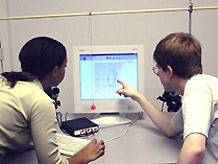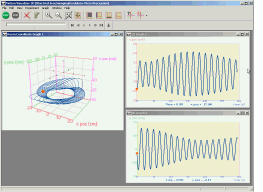|
The natural motions around us occur in 3-dimensional
space. Whether these motions are small, large, simple, or complex,
investigating the natural motions that interest us, and explaining
their behavior enriches the study of motion. It brings greater
engagement to the study of mathematics, kinematics, and Newton's
laws.
Motion Visualizer 3D captures
a natural motion and instantaneously displays it on a graph. Students
see the 3-dimensional motions in the world around them represented
in a 3-dimensional spatial graph that they can turn to view from
any perspective.
For example, here Motion Visualizer 3D captured
the motion of a free-swinging pendulum. This data clearly shows
the precession of the free-swinging pendulum and how it varies
in the x- and y-coordinates.
 The
3-dimensional spatial graph forms a concrete reference from which
the variables of position, velocity, and acceleration can be extracted
and displayed on conventional kinematics graphs that are correlated
back to the physical event that caused the motion. The
3-dimensional spatial graph forms a concrete reference from which
the variables of position, velocity, and acceleration can be extracted
and displayed on conventional kinematics graphs that are correlated
back to the physical event that caused the motion.
View enlarged image of the screenshot
View rotating image
of the 3D graph
In this way, Motion Visualizer 3D bridges the gap
between the 3-dimensional world and the graphic representations
that are central to the study of motion.
|